- Intellectual Property Rights (IPR)
- Pochampally Ikat (Andhra Pradesh) (GI Regn No. 4)
- Gadwal Sarees (Andhra Pradesh) (GI Regn No. 137)
- Uppada Jamdhani Sarees (Andhra Pradesh) (GI Regn No.122)
- Banaras Brocades & Sarees (UP) (GI Regn No. 99)
- Lucknow Chikan Craft (UP) (GI Regn No. 119)
- Paithani Saree & Fabrics (Maharashtra) (GI Regn No. 150&153)
- Khandua Sarees & Fabrics (Odisha) (GI Regn No. 136)
- Pipli Appliqué Work (Odisha) (GI Regn No. 86&108)
- Kasaragod Sarees (Kerala) (GI Regn No. 170)
- Kuthampully Sarees (Kerala) (GI Regn No. 179)
- Chendamangalam Dhoties & Set Mundu (Kerala) (GI Regn No. 225)
Intellectual Property Rights (IPR)
The potential of unique handloom and handcrafted products of India has been well demonstrated for the country’s economic development in the globalised era. The integration of the global economy under the WTO framework has not only brought about windows of opportunities by market expansion but also created plethora of challenges for the unique products of the country in the form of large scale infringement by other sectors, manufacturers and also by other countries. It has threatened the very existence of these unique products and adversely affected the livelihood of the economically backward stakeholders of these products. In view of the growing threat to the intellectual properties of these products, the member countries of WTO including India have signed the TRIPS agreement in 1994 with a pledge to protect the intellectual property of the member countries. In pursuance of the TRIPS Agreement, the Indian Parliament has passed the Geographical Indication Act in 1999 and Rules in 2002 (GI), the same has been implemented in the year 2003. The Act provides guidelines for IPR protection of the unique products of different sectors like textiles and clothing, agriculture, handicrafts, horticulture, etc. The much needed protection will help the genuine producers to protect them from the counterfeit goods for their own advantage.
Keeping these aspects in mind, Textiles Committee has taken up a project to facilitate the GI registration of unique textile products of the country. As most of the stakeholders of the unique products in the country are not aware of the GI Act, Textiles Committee has initiated a nationwide campaign for creating awareness amongst the stakeholders at all levels and also facilitating them for registration of the products and post-GI initiatives. Textiles Committee has facilitated the GI registration of unique textiles products of Andhra Pradesh, Odisha, Kerala, Utter Pradesh, Maharashtra, Gujarat and Tamil Nadu.
- Pochampally Ikat (Andhra Pradesh)(GI Regn No. 4)
- Gadwal Sarees (Andhra Pradesh) (GI Regn No. 137)
- Uppada Jamdhani Sarees (Andhra Pradesh) (GI Regn No.122)
- Banaras Brocades & Sarees (UP)>(GI Regn No. 99)
- Lucknow Chikan Craft (UP>)(GI Regn No. 119)
- Paithani Saree & Fabrics (Maharashtra>)(GI Regn No. 150 &153)
- Khandua Sarees & Fabrics (Odisha>)(GI Regn No. 136)
- Pipli Appliqué Work (Odisha>)(GI Regn No. 86&108)
- Balaramapuram Sarees & Fine Cotton Fabrics (Kerala>)(GI Regn No. 152)
- Kasaragod Sarees (Kerala>)(GI Regn No. 170)
- Kuthampully Sarees (Kerala>)(GI Regn No. 179)
- Chendamangalam Dhoties & Set Mundu (Kerala>)(GI Regn No. 225)
Pochampally Ikat (Andhra Pradesh) (GI Regn No. 4)
Pochampally, a small town in Nalgonda district of Andhra Pradesh is famous for Ikat weaving. Ikat is a type of weaving wherein the warp, weft or both are tie-dyed before weaving to create designs on the finished product. The precision of warping determines the charity of designs. Pochampally products are hand crafted to perfection by skilled artisans who are endowed with critical skills in an intricate designs, having decades of experience in their respective fields. The weavers are producing different products like Sarees, Dress materials, home furnishings by using silk, cotton yarn and jari. The artistic skill of the weavers, which got reflected in the products, has always attracted attention of the people across the country and abroad.
Gadwal Sarees (Andhra Pradesh) (GI Regn No. 137)
Shri Sita Ram Bhoopal Bahadur, the king of Gadwal during the period (1807– 1840) was ambitious and wanted that the weavers of Gadwal to produce a valuable fabric, similar to Banaras. In 1822 three weavers from Gadwal were sent to Banaras to acquire the art of silk weaving. With committed efforts, they learnt the weaving techniques and on return to home started weaving beautiful sarees with imported tools and designs. This is the beginning of the silk weaving in the Gadwal cluster. The present Gadwal saree is the result of innovations introduced by Maharani Adi Lakshmi Devi Amma. She collected Venkatgiri sarees and advised the weavers to weave sarees in similar patterns. This development has led to introduction of fine count of yarns for weaving Gadwal Saree. The weavers of Gadwal and surrounding areas are highly skilled in weaving sarees with high degree of variation by applying the permutation and combinations of the colours, the designs, the motifs in Pallu, in the borders, by change of fibre etc.
Uppada Jamdhani Sarees (Andhra Pradesh) (GI Regn No.122)
Jamdhani has been derived from a Persian word- “Jam” meaning Cup and ‘dani’ meaning Container. From the available literature it is given to understand that the art of Jamdhani weaving at Uppada and Kothapally is 200 yrs old. The rulers of ‘Pithapuram, Bobbili, Venkatagiri, Nuzividu and Guraja’ princely states patronized the art. A small kingdom namely Chitrada Samsthanam (17th Century AD) with Pithapuram as capital, was instrumental for the upcoming of Uppada Jamdhani Art. Pithapuram still exists in the same name now. Weavers of Uppada, Kothapally and Pithapuram used to weave sarees exclusively for queens and were not allowed to publicize the style of weaving. Under their royal patronage, these weavers prospered well and produced some beautiful and unique products. The raw material i.e. Fine Cotton of counts 150s, 120s and 100s , Jari and Gold yarns, which are also used for weaving, were imported for weaving traditional Jamdhani Products. With the passage of the time, the Art lost its importance due to change in consumer demand patterns. During the slag period, cotton saress with small buta were woven with the help of Lattice Dobby. The Jamdhani weaving of the Uppada is cluster based and scattered in mainly five villages of Kothapalli mandal. The five villages are ‘Uppada, Kothapally, Ameenabad, Komaragiri and Ramannapalem’. Among these, Uppada and Kothapally are the most important centers and more than 60 percent of Jamdhani Weaving is practiced at these two villages.
Banaras Brocades & Sarees (UP) (GI Regn No. 99)
Banaras Brocades & Sarees originated from the holy city of Varanasi in Uttar Pradesh catch the imagination of the world for its intricate designs and craftsmanship of weavers. It is believed that the product originated during Vedic period and flourished during the time of Moguls during 16th Century. The product is famous for its patterns, motifs, colorful gold and silver zari. The weavers of Banaras weave their imagination in the form of Brocades & Sarees which have attracted the attention of many famous personalities. At present, the weavers weave products like Sarees, Brocaded fabrics, dress material, home furnishing with glamorous appeal & bright colours by using silk yarn and zari. Download Report![]() 5.64 MB
5.64 MB
Lucknow Chikan Craft (UP) (GI Regn No. 119)
The Chikan Craft is the transformation of the finest cotton and organdie fabrics into flowing yards of magic by the skillful artistic work of the artisans of Lucknow. The artisans combine thirty-two stitches, five derivatives with their imaginations of faith and natural surroundings, cultural ethos and traditions to shape this wonderful embroidery, which has attracted the attention of world. Patronized by the then Nawabs of Oudh, Moguls, it may be the first artistic work of India participated and awarded in the coronation exhibition held at London in 1911. The uniqueness of the product lies in the different stitches, motifs and the geometrical pattern followed by the artisans in the process of embroidery making. At present, more than 2.5 lakh artisans are making this embroidery on different products like Kurta, pyjama, kameez, shirts, ladies wear, sarees, home furnishings etc. In fact, the art style is unparalleled in its flexibility and versatility and has always permitted experimentation and encouraged innovation.
Paithani Saree & Fabrics (Maharashtra) (GI Regn No. 150&153)
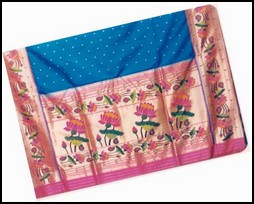
The hand woven silk Sarees of Maharashtra has distinctive style of its own with bold patterns and traditional motifs conveying the typical cultural heritage. It has been originated in Paithan (Dist: Aurangabad) during the 6th century B.C. and subsequently spread to other areas like Yeola (Dist: Nashik) of the state. The art style embedded in the product is innovative and has appealing dynamism. The uniqueness of the product lies with special designs in Pallu and its borders. The artisans have woven their art forms from the myths, faiths, symbol and natural surroundings providing an appealing dynamism. Intricate design on Pallu and border is the specialty of Paithani Sarees and fabrics. The motifs woven in the Sarees like peacock, lotus, mango and other designs have been borrowed from the rock-cut caves of Ajanta and Ellora. The weavers use silk yarn and zari with various specifications to produce their products.
Khandua Sarees & Fabrics (Odisha) (GI Regn No. 136)
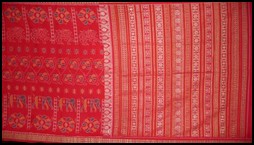 Reflecting God’s delight in man’s work and having a close-knit relation with the Lord Jagannath culture “Khandua Sarees & Fabrics” are astonishingly pleasing with aesthetic colour combinations. The handloom cluster of Nuapatna in Cuttack district of Orissa proudly owes its origin to 12th century AD. Popular folklore has it that Jaydev the great poet desired to offer his creation to Lord Jagannath through “IKAT” designs on fabric and prepared the same in his birthplace “Kenduli” and this is how Khandua Sarees originated. Since then the Khandua Sarees with fascinating motifs and designs, rich colours and fine textures from village Nuapatna and Maniabandh have been handed down from generation to generation as a heavenly gift to the world. Popularly known as Bandha or Ikat, the uniqueness of the product is the method of tie & dye practiced by the weavers, motif and colour combination used in the process of production. The Sarees have a close-knit relation with the Jagannath cult. Yellow coloured Ikat fabric for Lord Jagannath symbolizes salvation, green for Balabhadra symbolizing life and red for Subhadra signifying power of Shakti. Even the motifs such as the temple border, lotus, conch and wheel signify the affinity with the reigning deity. Now a days the weavers are producing different products like Sarees, dress material, bed sheets, curtains, etc. which are popular in the country.
Reflecting God’s delight in man’s work and having a close-knit relation with the Lord Jagannath culture “Khandua Sarees & Fabrics” are astonishingly pleasing with aesthetic colour combinations. The handloom cluster of Nuapatna in Cuttack district of Orissa proudly owes its origin to 12th century AD. Popular folklore has it that Jaydev the great poet desired to offer his creation to Lord Jagannath through “IKAT” designs on fabric and prepared the same in his birthplace “Kenduli” and this is how Khandua Sarees originated. Since then the Khandua Sarees with fascinating motifs and designs, rich colours and fine textures from village Nuapatna and Maniabandh have been handed down from generation to generation as a heavenly gift to the world. Popularly known as Bandha or Ikat, the uniqueness of the product is the method of tie & dye practiced by the weavers, motif and colour combination used in the process of production. The Sarees have a close-knit relation with the Jagannath cult. Yellow coloured Ikat fabric for Lord Jagannath symbolizes salvation, green for Balabhadra symbolizing life and red for Subhadra signifying power of Shakti. Even the motifs such as the temple border, lotus, conch and wheel signify the affinity with the reigning deity. Now a days the weavers are producing different products like Sarees, dress material, bed sheets, curtains, etc. which are popular in the country.
Pipli Appliqué Work (Odisha) (GI Regn No. 86&108)
The Pipli Applique work of Orissa originated in the Pipli of Puri district owes its origin to Lord Jagannath culture during 12th century. The coloured clothes are stitched in shape of animals, birds, flowers and beautiful walls on the base cloth to produce variety of decorative products. This artistic work is as old as the Lord Jagannath Temple of Puri and is an opulent artistic heritage of the country that draws specimens from the temple architecture. The artistic skill of the artisans when combined with different distinguished stitches practiced on plethora of beautiful motifs give rise to this unique product. At present, the artisans are producing products like wall hangings, bed sheets, lamp shed, beach umbrella, umbrella, bags, ladies bag etc. & some traditional religious products, which are very popular among the tourists visiting Orissa.
Balaramapuram Sarees & Fine Cotton Fabrics (Kerala) (GI Regn No. 152)
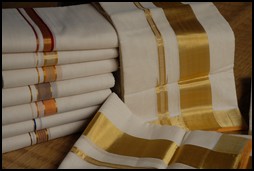 These wonderful hand-woven Sarees and textile products of Balaramapuram in Kerala are magnificent in their un-dyed natural colour cotton yarn inter-woven with jari. The product is basically a cream stretch of cloth with gold jari embroidered in the Pallu and body. The history of handloom weaving in Balaramapuram dates back to about 200 years ago and is associated with the royal family of Travancore (or Thiruvithamkur in Malayalam). The then Maharaja Balarama Varma (from 1798 to 1810) brought weaving families from Valliyoor of the Tamil Nadu state. These weavers’ produced super-fine clothes for the need of the Travancore royal family. The traditional handloom products of Balaramapuram are well known for their simplicity, use of natural materials and exquisite designs with unrivalled craftsmanship. The yarn used is of natural grey colour and no dyes are used in the warp. It is woven from un-dyed natural cotton that compliments the tropical climate of Kerala. It is usually a cream stretch of cloth with gold zari or "Kasavu" (exquisite embroidery work created from silver wires coated with gold) borders.
These wonderful hand-woven Sarees and textile products of Balaramapuram in Kerala are magnificent in their un-dyed natural colour cotton yarn inter-woven with jari. The product is basically a cream stretch of cloth with gold jari embroidered in the Pallu and body. The history of handloom weaving in Balaramapuram dates back to about 200 years ago and is associated with the royal family of Travancore (or Thiruvithamkur in Malayalam). The then Maharaja Balarama Varma (from 1798 to 1810) brought weaving families from Valliyoor of the Tamil Nadu state. These weavers’ produced super-fine clothes for the need of the Travancore royal family. The traditional handloom products of Balaramapuram are well known for their simplicity, use of natural materials and exquisite designs with unrivalled craftsmanship. The yarn used is of natural grey colour and no dyes are used in the warp. It is woven from un-dyed natural cotton that compliments the tropical climate of Kerala. It is usually a cream stretch of cloth with gold zari or "Kasavu" (exquisite embroidery work created from silver wires coated with gold) borders.
Kasaragod Sarees (Kerala) (GI Regn No. 170)
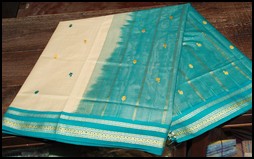 The origin of the handloom weaving of Kasaragod Sarees is traced back to 18th century AD. The history states that the weaving community, the Shaliya (or the Chaliya/ Saliya), has been migrated from East Karavali cost of the present Karnataka State en route Tamil Nadu. It is widely believed that another group of Padmashaliyas reached the present Kasaragod taluk from Mysore and surrounding regions of the present Karnataka. Traditional accounts identify fourteen settlements of this community from Pattuvam in Kannur to Panambur in Mangalore. The unique colour combination is the main speciality of the Sarees produced in Kasaragod. The dye which is predominantly used for dyeing the yarn meant for Kasaragod Saree is Vat dyes. The vat dyes are preferred by the manufacturer of Kasaragod sarees over all other groups of available dyes is due to its excellent colour fastness properties. These dyes are the fastest dyes available for dyeing cellulosic fibres. Therefore, the Kasaragod Sarees are famous for its luster and colour fastness due to the best dyeing quality and techniques.
The origin of the handloom weaving of Kasaragod Sarees is traced back to 18th century AD. The history states that the weaving community, the Shaliya (or the Chaliya/ Saliya), has been migrated from East Karavali cost of the present Karnataka State en route Tamil Nadu. It is widely believed that another group of Padmashaliyas reached the present Kasaragod taluk from Mysore and surrounding regions of the present Karnataka. Traditional accounts identify fourteen settlements of this community from Pattuvam in Kannur to Panambur in Mangalore. The unique colour combination is the main speciality of the Sarees produced in Kasaragod. The dye which is predominantly used for dyeing the yarn meant for Kasaragod Saree is Vat dyes. The vat dyes are preferred by the manufacturer of Kasaragod sarees over all other groups of available dyes is due to its excellent colour fastness properties. These dyes are the fastest dyes available for dyeing cellulosic fibres. Therefore, the Kasaragod Sarees are famous for its luster and colour fastness due to the best dyeing quality and techniques.
Kuthampully Sarees (Kerala) (GI Regn No. 179)
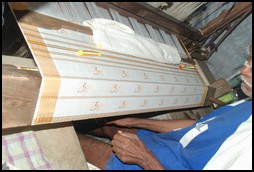 The origin of the Kuthampully Sarees and other fine cotton fabrics of Kerala is traced back to the end of the 18th century AD, as the product is closely associated with the Royal family of Kochi. History says that the members of Devanga Chettiar, a community of traditional weavers and having roots in the then Mysore state of the present Karnataka, were brought by the Kochi Royal family to weave dress materials exclusively for the palace. It is also believed that the Devanga Chettis from Mysore, left their country on account of Tipu Sultan’s persecution and settled in this out-of-the-way village about the end of the eighteenth century. The uniqueness of the products of this cluster is the usage of Hal-fine Zari in the border, cross-border or pallav of the traditional Sarees. No bleaching or dyeing is involved in the process except for the dyed yarn used in the weft for the border or cross-border. The products are eco-friendly.
The origin of the Kuthampully Sarees and other fine cotton fabrics of Kerala is traced back to the end of the 18th century AD, as the product is closely associated with the Royal family of Kochi. History says that the members of Devanga Chettiar, a community of traditional weavers and having roots in the then Mysore state of the present Karnataka, were brought by the Kochi Royal family to weave dress materials exclusively for the palace. It is also believed that the Devanga Chettis from Mysore, left their country on account of Tipu Sultan’s persecution and settled in this out-of-the-way village about the end of the eighteenth century. The uniqueness of the products of this cluster is the usage of Hal-fine Zari in the border, cross-border or pallav of the traditional Sarees. No bleaching or dyeing is involved in the process except for the dyed yarn used in the weft for the border or cross-border. The products are eco-friendly.
Chendamangalam Dhoties & Set Mundu (Kerala) (GI Regn No. 225)
Chendamangalam Cluster, another centre of traditional handloom weaving, produces the traditional varieties of clothing, Dhoties and Set Mundu. The Set Mundu or Mundum Neriyathum is a combination of Mundu (or Dhoti) for covering the lower part of the body and Neriyathu to wrap around the upper portion of the body like a Dupatta over the blouse. The Set Mundu is the traditional clothing of women in Kerala and is the oldest remnant of Saree. The Set Mundu consists of two pieces of cloth, the Dhoti or Mundu and Neriyathu or Kavani. The history of Chendamangalam handloom is closely associated with the Feudal Family of Paliam, whose eldest male members, had been the Chief Ministers of the Rajas of Cochin and represented the Perumpatappu Swarupam. The handloom weavers of the village had been patronized by successive Paliyath Valiyachans, the head of the family. In the early days of its origin at Chendamangalam, the weaving of handloom clothes was mainly done for the members of the Paliam family. The women of this family used to show off their dignity in dressing by wearing the Puliyilakkara Neriyathu, Kasavu Dhoti, Kasavu Sarees and other varieties of Chendamangalam handloom products. It was due to the high degree of excellence in the dexterity of fabrics manufactured by the weavers at Chendamangalam.
